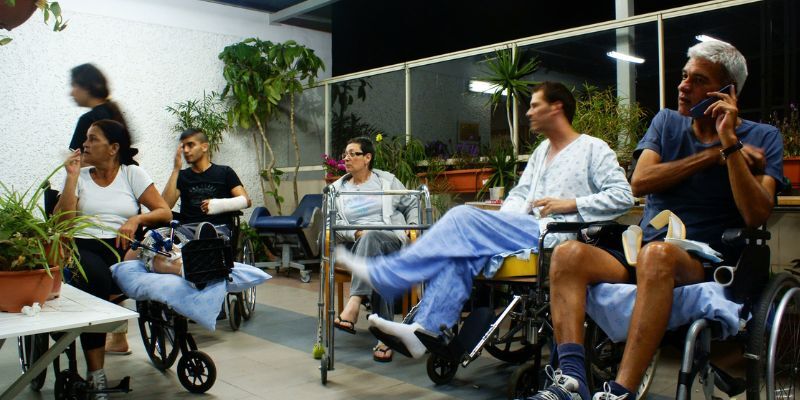In healthcare, “long wait times” refer to the extended periods patients spend waiting for medical attention. This delay can occur in various settings, such as hospitals, clinics, and emergency rooms, and can significantly impact a patient’s experience.
Typical scenarios where long wait times for healthcare occur include crowded emergency rooms, specialist appointments, and diagnostic tests. Studies have shown that, on average, patients wait for over 20 minutes before seeing a healthcare provider, which can sometimes be much longer.
Addressing this issue is of paramount importance. Prolonged wait times can lead to frustration and anxiety and even worsen existing health conditions.
Healthcare providers can improve patient satisfaction by reducing wait times and ensuring timely access to essential medical care. Implementing effective strategies to streamline healthcare services and enhance the overall patient experience is crucial.
The Impact of Waiting Times on Patients
Long waiting times in healthcare significantly influence the overall patient experience. When individuals seek medical attention, they naturally expect timely care.
Long patient wait times can lead to frustration and anxiety, negatively affecting their perception of the healthcare system. These extended delays can disrupt the patient’s journey, potentially delaying diagnosis and treatment.
Studies and Statistics on the Correlation Between Wait Times and Satisfaction
Research consistently demonstrates a direct correlation between long wait times for healthcare and patient satisfaction.
Studies have revealed that patient satisfaction scores decrease as wait times increase. For instance, a study by the National Center for Biotechnology Information (NCBI) found that patients who experienced shorter wait times reported higher levels of satisfaction with their healthcare experience.
Real-World Examples of Hospitals Affected by Long Wait Times
Several hospitals have grappled with the challenge of extended patient wait times.
For instance, the Public Hospital at Jimma Zone experienced a surge in patient volume, leading to long wait times for appointments and services. This strained their resources and resulted in lower patient satisfaction scores.
Such instances highlight the critical need for healthcare providers to address and mitigate long wait times to enhance customer experience and ensure timely access to care.
By understanding the impact of waiting times on patients, healthcare providers can implement strategies to improve patient satisfaction, streamline services, and ultimately enhance the overall quality of care.
Economic Costs

Long wait times in healthcare affect patient satisfaction and have substantial economic implications for healthcare providers and businesses.
Lost Revenue Due to Customer Abandonment:
- Extended patient waiting times can lead to customer abandonment, where potential patients decide to seek care elsewhere or forego it altogether. This results in a direct loss of revenue for healthcare facilities.
- Patient feedback often highlights dissatisfaction with long wait times, indicating a clear correlation between wait times and revenue loss.
Opportunity Costs for Businesses:
Businesses, particularly those in the healthcare sector, face opportunity costs when resources are tied up in managing long wait times. These resources could be utilized more efficiently in other aspects of patient care or operational improvements.
For example, the average wait time for a doctor’s appointment in the U.S. is approximately 20.6 days. This extensive period can hinder the ability of healthcare providers to schedule and serve a higher volume of patients.
Long-Term Effects on Patient Loyalty and Repeat Business:
- Patient loyalty and repeat business are crucial for the sustainability of healthcare providers. Long wait times can erode patient trust and confidence in a healthcare facility, potentially leading to a loss of long-term patronage.
- Additionally, patients who experience extended wait times are more likely to seek alternatives in the future, contributing to reduced patient retention rates.
Addressing patient waiting time is vital for improving the overall patient experience and safeguarding the economic interests of healthcare providers and businesses.
By implementing strategies to reduce wait times in healthcare, providers can enhance revenue streams, optimize resource allocation, and foster patient loyalty for sustained success in the industry.
Employee Productivity and Morale
Extended wait times in healthcare burden patients and take a toll on healthcare professionals. Coping with prolonged patient queues can lead to heightened stress levels among staff, leading to diminished job satisfaction and a decline in the quality of care provided.
- Prolonged wait times contribute to increased employee stress and potential burnout.
- Elevated stress levels can hinder staff performance and job satisfaction.
- Quality of care may need to be improved due to overwhelmed and stressed healthcare professionals.
Strategies for Sustaining Employee Morale During Peak Periods
In times of high patient volume and long wait times, it is imperative to employ measures that bolster employee morale.
Business analytics can be harnessed to forecast peak periods, aiding resource allocation. Rotating staff to prevent burnout, offering regular breaks, and providing training in stress management techniques are effective ways to maintain employee morale and performance.
- Utilize business analytics to predict high-traffic periods and allocate resources accordingly.
- Implement staff rotation schedules to prevent burnout and maintain morale.
- Offer regular breaks and stress management training to support employee well-being.
Striking a Balance between Customer Service and Employee Well-being
Maintaining an equilibrium between exceptional customer service and employee well-being is critical in healthcare settings. While delivering top-notch patient care is a priority, safeguarding the welfare of healthcare professionals is equally crucial.
Streamlining workflows through technology like queue management systems, adopting efficient processes, and fostering a supportive work environment is pivotal in achieving this balance, ultimately benefiting patients and employees.
- Implement technology and efficient workflows to streamline processes.
- Foster a supportive work environment that prioritizes employee well-being.
- Strive for a harmonious equilibrium between exceptional patient care and staff welfare.
Technological Solutions

Technology is pivotal in mitigating long wait times in healthcare by enhancing efficiency and optimizing patient flow. A patient flow management system can help streamline processes, ensuring patients move seamlessly through their healthcare journey.
This technology enables healthcare providers to allocate resources more effectively, reducing bottlenecks and minimizing wait times.
- Patient flow management systems facilitate the smooth progression of patients through various stages of care.
- They provide real-time data and analytics, allowing for proactive resource allocation and capacity planning.
- Automated notifications and alerts help staff stay informed, enabling them to respond promptly to patient needs.
Examples of Successful Implementation of Tech Solutions
Several healthcare facilities have successfully integrated technology to address long wait times. For instance, AlMoosa, a leading healthcare provider, collaborated with Wavetec to deploy a Queue Management System in response to the COVID-19 pandemic
This allowed them to reduce crowds and infection risks and enhance customer communication and education through digital signage.
Another example is McLeod Health’s adoption of Wavetec’s UNO-Q solution. It revolutionized patient experiences across 45 medical centers in the United States, significantly reducing wait times and optimizing queuing efficiency.
Challenges and Considerations in Adopting New Technologies
While technological solutions hold great promise in alleviating long wait times, there are challenges to consider. Upfront investment costs, staff training, and potential resistance to change must be addressed. Additionally, ensuring that the chosen technology integrates seamlessly with existing systems is crucial for its success.
- Initial investment and implementation costs may be a barrier for some healthcare facilities.
- Adequate training and support for staff during the transition period are essential for successful adoption.
- Compatibility with existing systems and workflows should be carefully assessed to avoid disruptions in operations.
Strategies For Improvement
In healthcare, the efficiency of patient flow and queue management systems can significantly impact the overall experience for patients. By employing effective strategies, healthcare facilities can reduce wait times and enhance the quality of care provided.
1. Analyzing and Optimizing Patient Flow
- Conduct thorough assessments of patient flow patterns to identify bottlenecks and areas for improvement.
- Implement process changes, such as staggered appointment scheduling or streamlined registration procedures, to optimize the flow of patients.
2. Implementing Effective Queue Management Systems
- Utilize advanced patient queue management technology like virtual queuing to digitize and streamline the waiting experience for patients.
- Integrate digital displays and notifications to keep patients informed about their status in the queue, minimizing perceived wait times.
3. The Importance of Communication During Wait Times
- Foster clear and transparent communication with patients about expected wait times and the reasons behind any delays.
- Provide informative materials or digital displays in waiting areas to educate and engage patients while they wait.
4. Staff Training and Empowerment
- Provide staff with training on efficient workflows and customer service skills to handle patient queues effectively.
- Empower staff to make real-time decisions to address unexpected situations or emergencies promptly.
5. Technology Integration for Appointment Management
- Implement digital platforms for appointment scheduling and reminders, reducing no-shows and optimizing appointment slots.
- Integrate electronic health record systems to streamline access to patient information, improving overall efficiency.
6. Data-Driven Decision Making
- Utilize data analytics to monitor and analyze patient flow patterns, enabling evidence-based workflow and resource allocation adjustments.
- Leverage key performance indicators (KPIs) to track the impact of implemented strategies and make continuous improvements.
7. Patient Feedback and Continuous Improvement
- Actively seek and value patient feedback regarding their waiting experiences, using it as a basis for ongoing improvements.
- Engage in regular evaluations and adjustments to the implemented strategies, ensuring they remain effective and responsive to patient needs.
By implementing these strategies, healthcare facilities can create a more streamlined and patient-centered environment, ultimately enhancing the overall quality of care and reducing long wait times for healthcare.
Case Studies

Transforming Patient Experiences: Ministry of Health UAE’s Technological Leap
The Ministry of Health in UAE partnered with Wavetec to implement advanced Queue Management and Signage Solutions. This overhaul streamlined patient flows, reduced anxiety, and eliminated long waits.
Through virtual queuing and tailored workflows, patients now experience a seamless process, ultimately leading to heightened satisfaction and efficiency. The new system has significantly curtailed customer complaints, marking a notable success in healthcare enhancement.
Efficiency Revolution: Chapidze Heart Center’s Patient Flow Management Success
The Chapidze Heart Center, a collaborative effort between Georgia and Germany, faced patient queues and navigation challenges. Wavetec, in partnership with Innotec, implemented a cutting-edge Patient Flow Management System, reducing wait times and enhancing patient experience.
Patients now navigate seamlessly through touchscreen kiosks, LED displays, and LCD screens. The system increased daily patient capacity from 70 to over 200, showcasing remarkable improvements in service efficiency.
Final Words
As explored, the long wait times for healthcare are critical challenges that demand urgent attention. Prolonged waiting periods can lead to increased patient anxiety, delayed diagnoses, and compromised health outcomes.
Addressing this issue requires a multi-faceted approach, including improvements in appointment scheduling systems, increased healthcare infrastructure, and the implementation of advanced queuing technologies.
Moreover, investing in healthcare staff training and expanding the workforce can help distribute the patient load more efficiently. Additionally, leveraging data analytics and technology-driven solutions can provide invaluable insights for optimizing patient flow.
Ultimately, reducing wait times is a matter of convenience and vital to ensuring timely access to quality healthcare services.
Healthcare systems worldwide must prioritize this issue, working collaboratively to create a more accessible, efficient, and patient-centric healthcare experience for all.
BOOK A FREE DEMO




